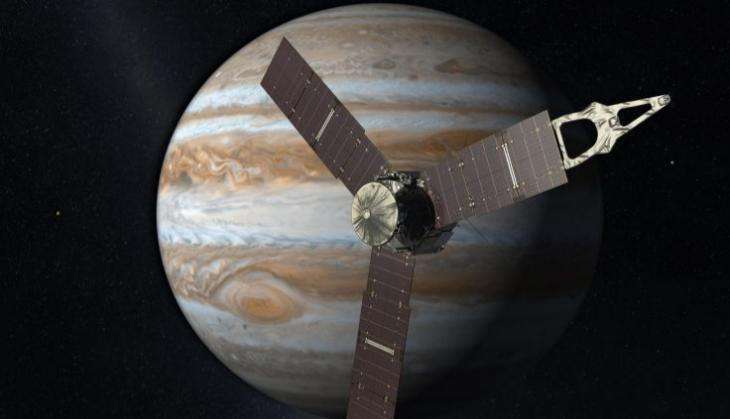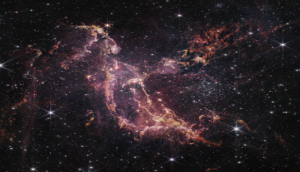
Juno, the second spacecraft designed under NASA's New Frontiers Program, took off on 5 August, 2011 and entered Jupiter's orbit on 4 July, 2016. The Juno spacecraft will orbit 37 times around the largest planet in the solar system in a span of 20 months to collect data on the planetary core, map the magnetic field and measure the amount of water and ammonia in the atmosphere.
Here are some interesting facts you must know about Juno :
1. NASA's Jet Propulsion Laboratory, Pasadena, California, manages the Juno mission for Principal Investigator Bolton. Lockheed Martin Space Systems, Denver, built the spacecraft.
2. Juno's principal goal is to understand the origin and evolution of Jupiter. It will measure the deep structure of the planet by measuring its composition, temperature, cloud motions, magnetic and gravity fields and its magnetosphere near the poles, especially the auroras.
3. The spacecraft will travel over a total distance of roughly 2.8 billion kilometres (1.74 billion miles)
4. According to Greek mythology, Juno is the name of a Roman Goddess, considered the wife of Jupiter.
5. The spacecraft is 11.5 feet (3.5 metres) high, and 11.5 feet (3.5 metres) in diameter and weighs around 7,992 pounds (3,625 kilograms).
6. The Juno mission investment is approximately $1.1 billion in total, which includes spacecraft development, science instruments, launch services, mission operations, science processing and relay support for 74 months.
7. Following the launch from Cape Canaveral Air Force Station, the spacecraft was scheduled to use its main rocket motor twice to modify its trajectory towards Jupiter. During the cruise, there were also 13 planned trajectory correction maneuvers to refine its orbital path.
8. The second burn of the Centaur Rocket (one of the main rockets of the space craft) on 4 July placed it on the desired departure trajectory.
9. Juno's trajectory to Jupiter comprises five phases over five years, namely: Inner Cruise 1 (61 days), Inner Cruise 2 (598 days), Inner Cruise 3 (161 days), and Quiet Cruise (791 days).
10. The speed of revolution will vary from 5 to 2 RPM, and it will turn back towards the Sun, and ultimately transmit telemetry via its high-gain antenna.
11. Power generation is provided by three solar arrays consisting 11 solar panels and one MAG boom. Two 55 amp-hour lithium-ion batteries provide power when Juno is away from the sun or in an eclipse phase. The power generation system is designed in such a way that it will help in data collection through microwave radiometry or gravity science.
12. Jupiter's orbit is five times farther from the Sun than the Earth's, so the amount of sunlight received by this planet is 25 times lesser than that of earth. Juno is the first solar-powered spacecraft designed to operate at such a great distance from the Sun. So, the solar cells used in it are 50% more efficient and radiation-tolerant than previously used silicon cells.
13. Juno's thermal control subsystem consists of an insulated, louvered electronics vault atop an insulated, heated propulsion module that help it to sustain cold temperature.
14. For weight saving and redundancy, Juno has a dual-mode propulsion subsystem, with a bi-propellant main engine and mono-propellant reaction control system thrusters. It also has the first-of-its-kind radiation shielded electronics vault, to protect sensitive spacecraft electronics.
15. The Juno spacecraft has 29 sensors, which feed data to nine onboard instruments namely:
- MAG to get an idea of Jupiter's magnetic field
- MWR to provide data on the structure, movement and chemical composition of the planet
- Gravity Science to measure Jupiter's gravitational field and reveal the planet's internal structure
- Waves to investigate Jupiter's polar space environment
- JADE and JEDI to focus on the physics of Jupiter's intense and impressive northern and southern auroral lights
- UVS to take pictures of Jupiter's auroras in ultraviolet light
- JIRAM to study Jupiter's atmosphere in and around the auroras
- JunoCam to generate images for education and public outreach







![BJP's Kapil Mishra recreates Shankar Mahadevan’s ‘Breathless’ song to highlight Delhi pollution [WATCH] BJP's Kapil Mishra recreates Shankar Mahadevan’s ‘Breathless’ song to highlight Delhi pollution [WATCH]](http://images.catchnews.com/upload/2022/11/03/kapil-mishra_240884_300x172.png)

![Anupam Kher shares pictures of his toned body on 67th birthday [MUST SEE] Anupam Kher shares pictures of his toned body on 67th birthday [MUST SEE]](http://images.catchnews.com/upload/2022/03/07/Anupam_kher_231145_300x172.jpg)






